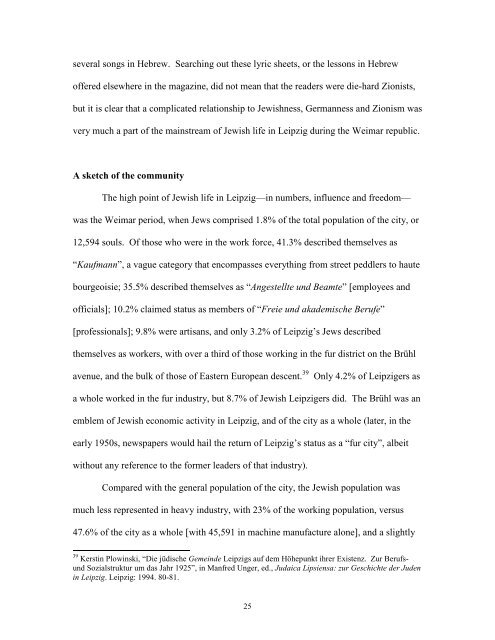Jews in Leipzig - The University of Texas at Austin
Jews in Leipzig - The University of Texas at Austin
Jews in Leipzig - The University of Texas at Austin
Create successful ePaper yourself
Turn your PDF publications into a flip-book with our unique Google optimized e-Paper software.
several songs <strong>in</strong> Hebrew. Search<strong>in</strong>g out these lyric sheets, or the lessons <strong>in</strong> Hebrew<br />
<strong>of</strong>fered elsewhere <strong>in</strong> the magaz<strong>in</strong>e, did not mean th<strong>at</strong> the readers were die-hard Zionists,<br />
but it is clear th<strong>at</strong> a complic<strong>at</strong>ed rel<strong>at</strong>ionship to Jewishness, Germanness and Zionism was<br />
very much a part <strong>of</strong> the ma<strong>in</strong>stream <strong>of</strong> Jewish life <strong>in</strong> <strong>Leipzig</strong> dur<strong>in</strong>g the Weimar republic.<br />
A sketch <strong>of</strong> the community<br />
<strong>The</strong> high po<strong>in</strong>t <strong>of</strong> Jewish life <strong>in</strong> <strong>Leipzig</strong>—<strong>in</strong> numbers, <strong>in</strong>fluence and freedom—<br />
was the Weimar period, when <strong>Jews</strong> comprised 1.8% <strong>of</strong> the total popul<strong>at</strong>ion <strong>of</strong> the city, or<br />
12,594 souls. Of those who were <strong>in</strong> the work force, 41.3% described themselves as<br />
“Kaufmann”, a vague c<strong>at</strong>egory th<strong>at</strong> encompasses everyth<strong>in</strong>g from street peddlers to haute<br />
bourgeoisie; 35.5% described themselves as “Angestellte und Beamte” [employees and<br />
<strong>of</strong>ficials]; 10.2% claimed st<strong>at</strong>us as members <strong>of</strong> “Freie und akademische Berufe”<br />
[pr<strong>of</strong>essionals]; 9.8% were artisans, and only 3.2% <strong>of</strong> <strong>Leipzig</strong>’s <strong>Jews</strong> described<br />
themselves as workers, with over a third <strong>of</strong> those work<strong>in</strong>g <strong>in</strong> the fur district on the Brühl<br />
avenue, and the bulk <strong>of</strong> those <strong>of</strong> Eastern European descent. 39 Only 4.2% <strong>of</strong> <strong>Leipzig</strong>ers as<br />
a whole worked <strong>in</strong> the fur <strong>in</strong>dustry, but 8.7% <strong>of</strong> Jewish <strong>Leipzig</strong>ers did. <strong>The</strong> Brühl was an<br />
emblem <strong>of</strong> Jewish economic activity <strong>in</strong> <strong>Leipzig</strong>, and <strong>of</strong> the city as a whole (l<strong>at</strong>er, <strong>in</strong> the<br />
early 1950s, newspapers would hail the return <strong>of</strong> <strong>Leipzig</strong>’s st<strong>at</strong>us as a “fur city”, albeit<br />
without any reference to the former leaders <strong>of</strong> th<strong>at</strong> <strong>in</strong>dustry).<br />
Compared with the general popul<strong>at</strong>ion <strong>of</strong> the city, the Jewish popul<strong>at</strong>ion was<br />
much less represented <strong>in</strong> heavy <strong>in</strong>dustry, with 23% <strong>of</strong> the work<strong>in</strong>g popul<strong>at</strong>ion, versus<br />
47.6% <strong>of</strong> the city as a whole [with 45,591 <strong>in</strong> mach<strong>in</strong>e manufacture alone], and a slightly<br />
39 Kerst<strong>in</strong> Plow<strong>in</strong>ski, “Die jüdische Geme<strong>in</strong>de <strong>Leipzig</strong>s auf dem Höhepunkt ihrer Existenz. Zur Berufsund<br />
Sozialstruktur um das Jahr 1925”, <strong>in</strong> Manfred Unger, ed., Judaica Lipsiensa: zur Geschichte der Juden<br />
<strong>in</strong> <strong>Leipzig</strong>. <strong>Leipzig</strong>: 1994. 80-81.<br />
25

















